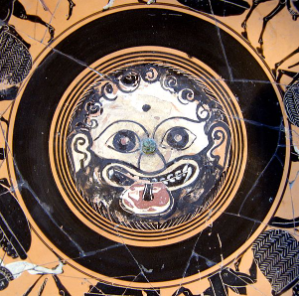
The Gorgoneion is a popular and recurring image in ancient Greek art, often depicted as a head with wild, writhing snakes for hair and bulging eyes that can turn anyone who gazes upon it to stone. It was believed that its magic could ward off harm or evil influences.
One notable example of the Gorgoneion in ancient Greek art is on the Tondo (circular central portion) of an Attic black-figure cup, which dates back to the 6th century BC.
On this cup, the Gorgoneion is prominently displayed in the center, surrounded by four smaller images of various animals. The image is highly detailed, with the snakes’ scales and individual strands of hair carefully etched into the clay. The image is thought to represent the protective power of the Gorgon, which was believed to ward off evil and protect the owner of the cup.
The Gorgoneion was a popular symbol in ancient Greece, often used as a protective talisman on clothing, armor, and even buildings. The image was also associated with the goddess Athena, who was said to have placed the head of the slain Gorgon, Medusa, on her shield (i.e. the Aegis) as a protective symbol.
After severing Medusa’s head from her body, Greek hero and demigod Perseus, as a gesture of gratitude, gave the Gorgon’s head to Athena as a votive gift.
























